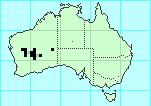
Common Name:
Delete this section if there is no common name.
Identification:
Males have fully developed wings, whereas females are micropterous,
with small lanceolate wings, and incapable of flight.
| (mm) |
Male |
Female |
| Body length |
44.0-55.0 |
64.0-82.0 |
| Head length |
2.7-3.0 |
4.5-5.1 |
| Tegmen length |
2.1-3.1 |
2.5-3.9 |
| Wing length |
26.8-29.6 |
3.6-6.0 |
| Cercus length |
1.6-2.0 |
1.5-2.1 |
This, coupled with the fact
that two of the three species (S. nelida and S. similis) oviposit on the Acacia plant on which they live, makes it
unlikely that they ever venture from their own host plant.
The body colour of both sexes is typically light to dark green.
Two stripes and furrows may, or may not, be present on the posterior
portion of the head. Rarely, the dorsum of the head and the base of the
legs have an orange tinge. In both sexes, the tegmen is a small round pad
with a dark brown or black patch dorsally, with or without grey spots.
Typically, a tubercular protrusion is located dorsally on the tegmen
and accommodates the basal portion of the wing sclerites ventrally.
The legs are brownish or greenish brown, somewhat darker near the junction
of the femur and tibia, but without any form of banding. Nocturnal.
Male
In the male the wing has a light grey-green anterior border (remigium).
The remainder of the wing is pink to purple, this being somewhat variable;
in every case the basal portion is much darker.
The fully alate males are highly vagile
and are commonly attracted to sources of light at night.
Subgenital plate short, apex broad or rarely with a notch; vomer narrow,
tooth elongate, spiniform, surface with regular elongate carinae. Tenth
tergite with teeth well defined, generally with a single row of larger
teeth, somewhat irregularly spaced. Cercus short, robust.
Female
The tiny female wing is grey or greenish grey on the remigium. Dorsally
it is inconspicuous, but when an individual is disturbed it spreads its
wings and reveals the intense, dark rosy pink coloration of the vannus.
Wing somewhat variable in length, apically lanceolate, widely separated or
slightly touching. Subgenital plate subacute to truncate. Tenth tergite
concealing 1/3 - 1/2 of cercus. Cercus relatively short, robust.
Eggs
 The eggs of this species are especially unique in that they are enclosed
in two thin membranes. Shortly after deposition, the membranes rupture
and a system of tubules in the operculum evert, forming a cluster of
stellate hairs resembling the bead of a dandelion. These are connected
to the egg and transport water to inhibit the eggs from desiccating.
The females oviposit on the Acacia plant on which they live;
eggs are laid in cracks in the bark of the host plant.
The eggs of this species are especially unique in that they are enclosed
in two thin membranes. Shortly after deposition, the membranes rupture
and a system of tubules in the operculum evert, forming a cluster of
stellate hairs resembling the bead of a dandelion. These are connected
to the egg and transport water to inhibit the eggs from desiccating.
The females oviposit on the Acacia plant on which they live;
eggs are laid in cracks in the bark of the host plant.
Habitat:
Inhabits the dry interior of the continent, where it lives on Mulga,
Acacia aneura. Nocturnal. During the day, males and females
hang motionless in the shelter of the leaves of their host plant.
Similar Species:
The other members of the Nelida group:
Sipyloidea nelida
and
Sipyloidea ovabdita.
Rearing Notes:
Rentz and John reared this species in the laboratory for cytological
studies. Few details were given. They were all successfully fed and
reared on Acacia longifolia var. soforae (Labill) F. Muell.
For a stick insect with body length 55mm, to keep 2 adult females,
you need a cage at least 250mm high, 120mm deep and 120mm wide.
 Range:
Range:
NW coastal, W plateau, WA
Status:
It is not known if this species is endangered,
as there is insufficient sighting history.
References:
-
Balderson, J., Rentz,
D.C.F. and Roach, A.M.E. (1998).
in
Houston, W.K.K. & Wells, A. (1998) (eds)
Zoological Catalogue of Australia.
Vol. 23.
Archaeognatha, Zygentoma, Blattodea, Isoptera, Mantodea, Dermaptera,
Phasmatodea, Embioptera, Zoraptera.
Melbourne: CSIRO Publishing, Australia (ISBN 0643 06035 9).
pp. 347 - 376.
-
John, B., Rentz, D.C.F. & Contreras, N. (1987).
Extensive chromosome variation in the stick insect genus Sipyloidea
Brunner von Wattenwyl (Phylliidae: Necrosciinae) within Australia, and
descriptions of three new species.
Invertebrate Taxonomy, 1: 603-630
- Search Google for
Sipyloidea similis,
or search Google Scholar for
Sipyloidea similis.
Copyright © 2000-2003
Peter Miller
This page was last changed 20-Sep-2006.
|

|

|
 The eggs of this species are especially unique in that they are enclosed
in two thin membranes. Shortly after deposition, the membranes rupture
and a system of tubules in the operculum evert, forming a cluster of
stellate hairs resembling the bead of a dandelion. These are connected
to the egg and transport water to inhibit the eggs from desiccating.
The females oviposit on the Acacia plant on which they live;
eggs are laid in cracks in the bark of the host plant.
The eggs of this species are especially unique in that they are enclosed
in two thin membranes. Shortly after deposition, the membranes rupture
and a system of tubules in the operculum evert, forming a cluster of
stellate hairs resembling the bead of a dandelion. These are connected
to the egg and transport water to inhibit the eggs from desiccating.
The females oviposit on the Acacia plant on which they live;
eggs are laid in cracks in the bark of the host plant.

 Range:
Range: 
